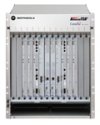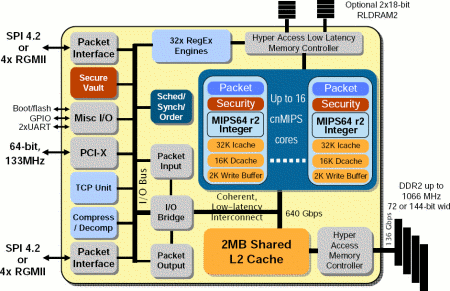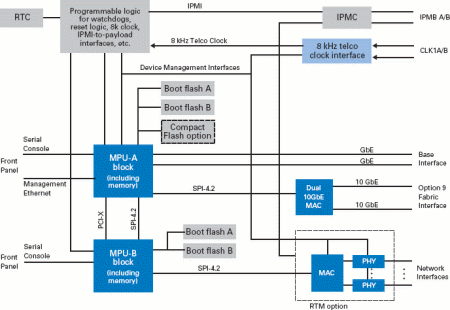Motorola touts Linux support for 32-way ATCA blade
Jun 13, 2007 — by LinuxDevices Staff — from the LinuxDevices Archive — views Motorola has announced an AdvancedTCA (ATCA) blade based on one or two 16-core MIPS64 processors. The ATCA-9301 blade runs Linux on Cavium's Octeon Plus architecture, and was designed to run applications that process and forward packets at line rates up to 10Gbps, Motorola said.
Motorola has announced an AdvancedTCA (ATCA) blade based on one or two 16-core MIPS64 processors. The ATCA-9301 blade runs Linux on Cavium's Octeon Plus architecture, and was designed to run applications that process and forward packets at line rates up to 10Gbps, Motorola said.
The ATCA-9301 blade is based on the top-end model in Cavium's Octeon family of processors, said to have been designed from the ground up to run both control- and data-plane applications on the same system. Such “infrastructure consolidation” can lower cost for network operators, according to Motorola.
Linux OS and tools vendor Wind River plans to support the ATCA-9301 out of the box with its Platform for Network Equipment, Linux Edition (PNE-LE). Along with Wind River's Eclipse-based Workbench toolsuite, PNE-LE can help streamline the development of applications for “data plane elements that include deep packet inspection,” Wind River said. Specific cited examples include network gateway and edge applications for 4G wireless and IPTV infrastructure.
The ATCA-9301 can be configured with one or two Cavium CN5860 MPUs (many-core processing units). Each CN5860 processor incorporates 16 MIPS64 cores clocked at 900MHz. The chips also integrate hardware acceleration for TCP, compression/decompression, regex, cryptography, and packet queuing and scheduling.

Cavium Octeon CN5860 block diagram
(Click to enlarge)
The ATCA-9301 supports up to 8GB of ECC DDR2 DRAM and dual (redundant) 64MB boot flash devices for each Cavium MPU. Other touted features include:
- PCI bus operation in 64-bit PCI-X mode
- Redundant GbE links to base channel on backplane and front panel GbE port
- Redundant 10 GbE links to backplane fabric interface
- Serial over LAN (SOL) support enables MPU-A/B communication across the network

ATCA-9301 architecture diagram
(Click to enlarge)
According to Jorge Magalhaes, marketing director for embedded communications at Motorola, “The ATCA-9301 blade's Cavium-based architecture permits packet processing tasks such as forwarding, packet inspection, and security functions to be done in parallel with control plane tasks. This will help providers to spend more time developing the broadest set of applications on a single platform and less time dealing with the power and cooling challenges of conventional communications processors.”
Availability
The ATCA-9301 will be available at an unspecified time, either as a standalone blade, or as part of Motorola's Centellis 3000 line. In the past, Wind River competitor MontaVista has also touted its support for Centellis 3000 products.
Interestingly, Cavium claims that its R&D team is led by the vestiges of the legendary Digital Equipment Corp. (DEC) engineering team responsible for the Alpha processor. Some of the first widely available 64-bit chips were based on Alpha, and Alpha was the second architecture (after x86) to support Linux, back in the mid-90s. Linux founder Linus Torvalds wrote the port himself, paving the way for ports to many other architectures, which quickly followed.
This article was originally published on LinuxDevices.com and has been donated to the open source community by QuinStreet Inc. Please visit LinuxToday.com for up-to-date news and articles about Linux and open source.